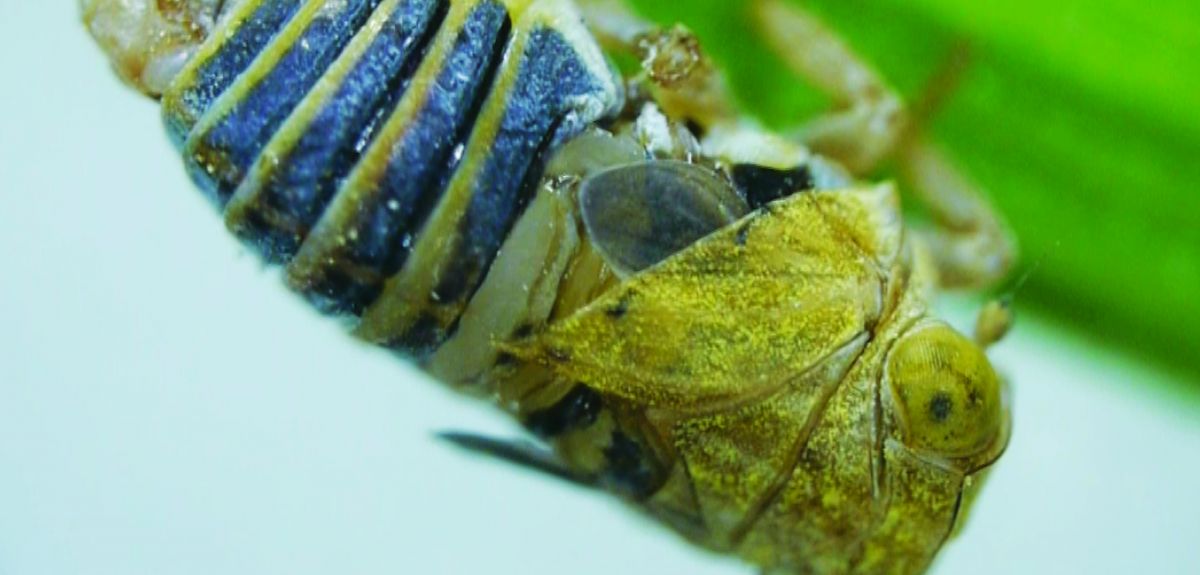
Credit: L.R. Davranoglou
Courting bugs attract mates using an elastic 'snapping organ' for vibrational communication
Planthopper bugs may be small, but they attract mates from afar by sending vibrational calls along plant stems and leaves using fast, rhythmic motions of their abdomen.
Researchers at the University of Oxford describe how a newly-discovered “snapping organ” enables courting bugs of both sexes to produce this shaking motion through a combination of muscle action and elastic recoil.
See the video:
Published in the open-access journal PLOS Biology, the study highlights how small animals can communicate at a distance despite the constraints of small body size.
Producing vibrations that will travel well along plant material requires the sudden release of mechanical energy – many times faster than could be achieved through direct action of the planthoppers’ tiny muscles.
The secret lies in the fast release of stored elastic energy, rather like a catapult, but with the key difference that the stored energy is released cyclically, leading to a repetitive up-down motion of the abdomen. This is accomplished by a complex anatomical structure that the researchers call the “snapping organ”, because of the speed with which it snaps open and closed.
The discovery of the new organ was as unexpected as its mechanism.
Lead author from the Department of Zoology, Leonidas-Romanos Davranoglou, said: ‘I was studying 3D images of planthoppers that I had collected using X-ray imaging in a particle accelerator, trying to understand the evolutionary relationships between different groups. But as I dissected the bugs in virtual reality on my computer, I immediately realised that I was looking at something entirely new, so decided to investigate further.’
Researchers collected hundreds of live planthoppers from the hills around Athens, which they brought back to their Oxford lab to conduct experiments. To understand the vibration generation mechanism of the new snapping organ, they used microtomography, laser vibrometry, confocal microscopy, and high-speed video recordings.
The scientists then teamed up with the University of Oxford’s Department of Engineering Science to build a mathematical model of the mechanism. The vibratory organ was found to be present in all of the many different families of planthoppers, showing that this entire group of bugs are specialists in this unusual form of communication.
Senior author Dr Beth Mortimer, Department of Zoology, said: ‘These insects include several economically important pest species, including the brown planthopper, which is one of the most serious pests on rice in the developing world. Understanding how these insects signal to each other may help in disrupting their communication channels or detecting their calls.
‘Silent to the ear, the planthoppers have come up with their own novel way to communicate with potential mates. You could say it’s their form of snap chat.’
While the discovery of the snapping organ is new, the method is an extremely old mechanism of communication, dating back at least 250 million years, to the dawn of planthopper evolution.
 New study reveals the COVID-19 pandemic’s impact on other causes of death
New study reveals the COVID-19 pandemic’s impact on other causes of death
 Researchers develop a way to test the ability of red blood cells to deliver oxygen by measuring their shape
Researchers develop a way to test the ability of red blood cells to deliver oxygen by measuring their shape
 New study calls for radical rethink of mental health support for adolescents
New study calls for radical rethink of mental health support for adolescents
 Oxford-led project awarded £2 million to revolutionise clean hydropower energy
Oxford-led project awarded £2 million to revolutionise clean hydropower energy
 Botanists name a beautiful new species of ‘lipstick vine’ discovered in the Philippine rainforest
Botanists name a beautiful new species of ‘lipstick vine’ discovered in the Philippine rainforest